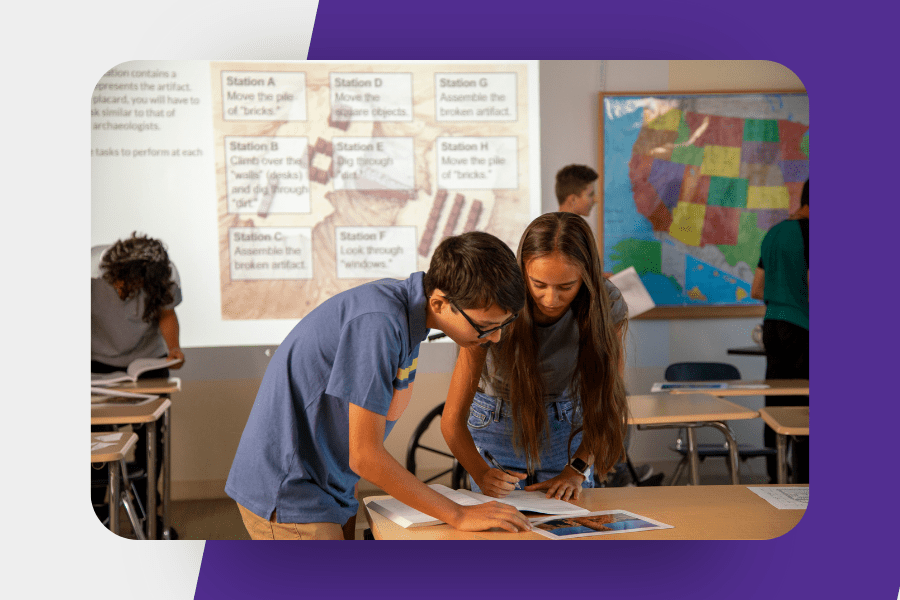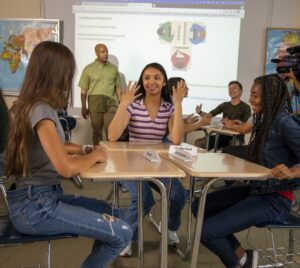
Creating lessons that truly engage students while meeting diverse classroom needs is a challenge every educator faces. Building a toolbox of teaching strategies can help educators meet the needs of students and bring social studies to life. Brian Thomas, a seasoned learning designer with over two decades of experience at TCI (Teachers’ Curriculum Institute), offers valuable insights into how educators can use effective, evidence-based strategies in the social studies classroom.
The Importance of Hands-On, Minds-On Learning
Engaging students is about more than just presenting content; it’s about creating an environment where they actively participate in their learning. This involves encouraging students to talk, debate, and collaborate with their peers, turning passive listening into dynamic interaction. By integrating activities that require movement and discussion, educators can foster critical thinking and deeper engagement with the material. This hands-on approach ensures that students are not just absorbing information but actively applying and exploring it, making subjects like social studies more meaningful and memorable.

Hands-on, minds-on activities are a cornerstone of effective curriculum design. These methods encourage students to think critically, collaborate with peers, and apply what they’ve learned in practical, often interactive, ways. For example, collaborative activities in geography or history lessons can transform abstract concepts into tangible experiences, helping students retain information and stay engaged.
When Thomas was a middle school teacher, he taught about the American Revolution in a hands-on, minds-on way. He took his students out to play capture the flag but set up the teams unequally. The team that seemed to have no chance of winning ended up victorious. Then Thomas shared, “Hey, everything that you just did is connected to the American Revolution.” He remembers students lighting up when they connected the activity to the American Revolution.
Getting students engaged in material through hands-on, minds-on strategies sets them up for success. Through active learning, students tap into their curiosity. When teaching about a social studies topic, consider how you might engage students in learning about the topic. Try integrating movement, visuals, or cooperative learning activities to bring learning to life.
Addressing Diverse Classroom Needs
No two students are alike, and educators must design lessons that accommodate the diverse needs of all learners. Meeting these varied needs often involves addressing differences in abilities, language proficiencies, and learning styles. By using a range of strategies, teachers can create lessons that are flexible enough to engage every student. This approach ensures that while a single lesson is being taught, necessary modifications are made so that all students can access and succeed in the material. Adapting lessons in this way helps create an inclusive learning environment where all students are set up for success.
An effective curriculum should include built-in flexibility, offering modifications and accommodations for all students to succeed. Providing different entry points for students ensures that everyone can access the material. Incorporating varied teaching strategies—visual aids, graphic organizers, and interactive activities—can help reach students with different learning preferences. This approach supports struggling learners and challenges advanced students, ensuring that no one is left behind.
When designing lessons, consider how you will address the needs of various learners within the same lesson. Think about how you can provide multiple entry points and ways for students to engage with the material. Building in choice and options into your lessons can provide ways to differentiate instruction.
On-Demand Professional Development
Even the best curriculum and strategies can fail if teachers are not equipped with the tools and support to implement them effectively. Ongoing professional development is essential for educators to stay updated on the latest teaching strategies, technological tools, and education research. TCI, originally founded as a company focused on providing professional development (PD), continues its strong commitment to supporting teachers’ growth and development.
Whether through in-person workshops, online courses, or peer collaboration, professional development allows teachers to enhance their skills and create more dynamic, inclusive classroom environments. Additionally, teachers need access to support whenever they need it, not just during scheduled PD sessions. Tools such as in-app professional development offer educators the flexibility to access resources 24/7, empowering them to apply new strategies when it’s most convenient for them. This on-demand support helps ensure that teachers can continuously grow and effectively implement the curriculum to benefit their students.
Integrating Technology in Social Studies Instruction
Technology plays a crucial role in education today, offering innovative ways to engage students and support diverse learning needs. When integrating technology into social studies lessons, it’s essential to use tools that enhance learning objectives without overwhelming students or teachers.
For instance, tech-enhanced tools can provide students with options like reading aloud in multiple languages, such as English or Spanish, to support language learners. Additionally, offering multiple reading levels or highlighting key phrases can help students grasp the main ideas more easily. Interactive elements like clickable maps, infographics, and images allow students to explore content in greater detail, making lessons more immersive and engaging.
When using video as a teaching tool, it’s important to incorporate activities that go beyond passive watching. For example, you can assign students a video-based activity where they interact with the content, answer questions, or complete a task related to the video. This type of pre-teaching activity helps introduce concepts while actively engaging students.
The key to using technology effectively is to ensure it complements, rather than replaces, foundational teaching methods. Thoughtfully applied, technology can open doors to interactive simulations, virtual field trips, and collaborative projects that make learning more dynamic and accessible for all students. The goal is to use these tools to enhance traditional learning, making lessons more engaging without sacrificing educational depth.
Teaching Strategies for Social Studies
While the principles of effective social studies instruction are universal, the tools and resources available to teachers can make a significant difference in how these principles are applied. TCI offers a range of curriculum solutions that embody the strategies discussed in this post. With a focus on hands-on, minds-on learning, TCI’s materials are designed to engage students in meaningful ways while supporting teachers with ready-made, flexible lessons.
TCI uses six core research-based teaching strategies: visual discovery, social studies skill builder, response group, experiential exercise, writing for understanding, and problem-solving group work.
To learn about the TCI curriculum and strategies, TCI offers ongoing support through in-app resources, webinars, and collaborative communities. By integrating technology into their curriculum, TCI provides teachers with innovative tools to enhance student learning, from interactive video activities to online assessments that offer immediate feedback.
Creating a curriculum that resonates with students and meets the diverse needs of the classroom is an ongoing challenge, but it is also one of the most rewarding aspects of teaching. As Brian Thomas illustrates through his experiences, focusing on hands-on, minds-on learning, addressing the diverse needs of students, and staying informed through professional development is key to creating an environment where all students can thrive. Strategies and resources like those offered by TCI can further enhance this process, helping teachers bring their best ideas to life in the classroom.






